Leopard 46: High-quality and robust catamaran proves agile in the YACHT test
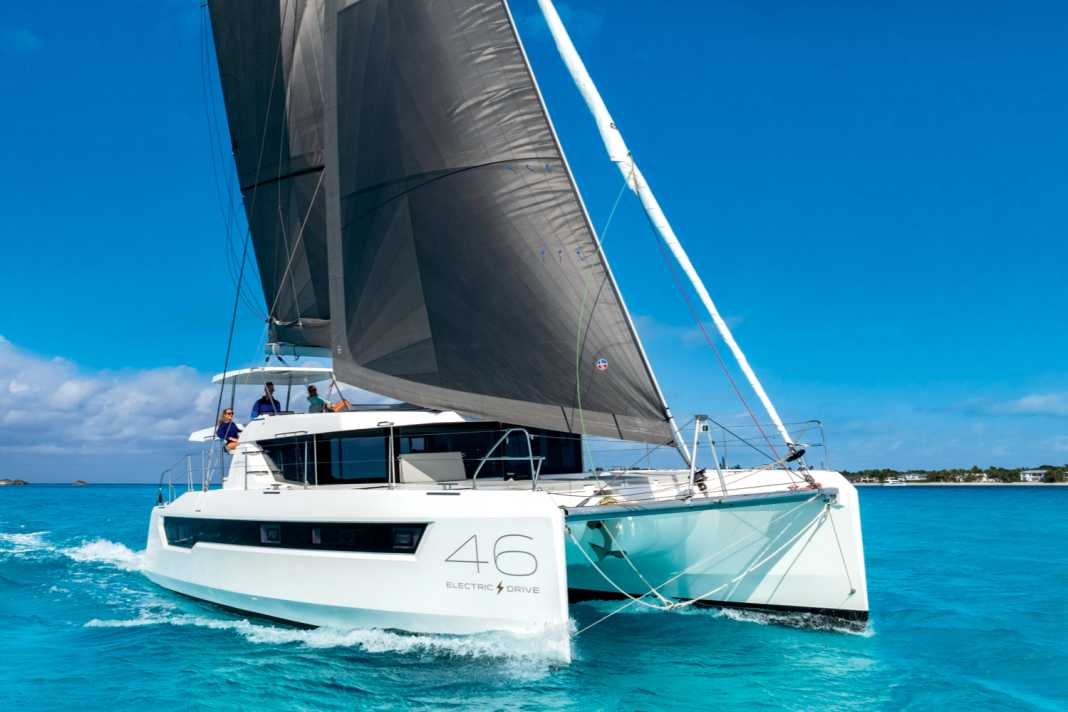





The forecasts do not bode well. Deep red wind fields appear in the usual weather apps. The mistral is raging in the otherwise peaceful and picturesque bay off Saint-Raphaël on the French Côte d'Azur. Even in the harbour, the anemometer at the masthead sometimes shows winds of up to 30 knots in the gusts.
The second reef is therefore prepared for the test of the new Leopard 46 as soon as the boat sets sail. The skipper announces that the genoa will only be partially unfurled for the time being. However, the dinghy for the photographer has to stay behind in the harbour, which is why the lovely lead image doesn't really match the harsh reality of the YACHT test on site.
More from the shipyard:
With a greatly reduced sail area, tacking is difficult at first. The catamaran can hardly gain any height and the high rudder pressure makes it difficult to steer precisely upwind. When the wind drops a little in the meantime, the genoa is fully unfurled. This significantly improves the sailing characteristics, in particular the rudder pressure is almost completely reduced. On a course of around 55 degrees to the true wind direction, the Leopard then reaches a speed of over eight knots. On the space wind course at a true wind angle of around 120 degrees, the log even shows double-digit values at times. This data was recorded at wind speeds of 20 to 25 knots.
Despite the demanding conditions, it is remarkable how quickly and agilely the catamaran moves and how precisely it can be steered and manoeuvred. The YACHT test editorial team was already able to observe the overall good sailing characteristics of the predecessor model Leopard 45 and the smaller Leopard 42 in very different conditions. The designs of all current Leopard Catamaran models (42, 46 and 52) now come from the Simonis/Voogd Yacht Design studio in the Netherlands and follow a fairly homogeneous design language.
Measured values of the Leopard 46
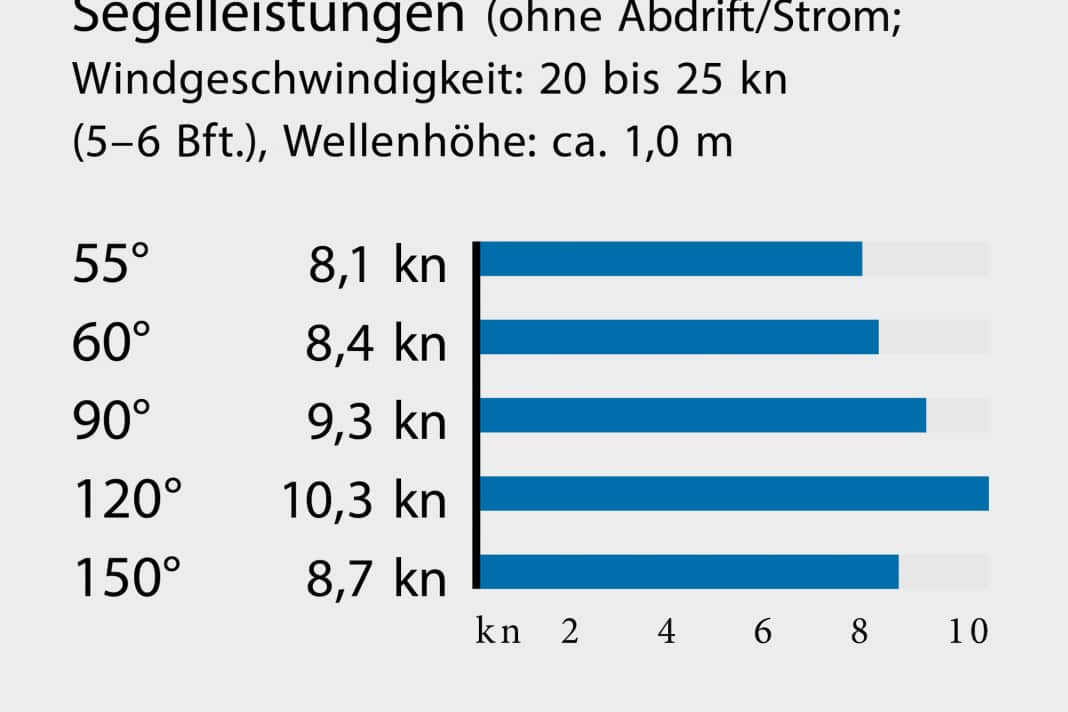


Two people can work in the cockpit at the same time
Compared to the Leopard 45, the new 46 is equipped with a significantly higher mast and therefore more sail area. However, as the boat is also heavier than its predecessor, the sail load factor remains unchanged at 4.5. A relatively large genoa with an overlap of 110 per cent is supplied as standard. The shipyard still does not offer a self-tacking jib.
Halyards, sheets as well as reefing and trim lines are led over the roof directly in front of the raised steering position, where they are very clearly organised. The shipyard has made this area much more spacious on the new model so that two people can now work in the cockpit at the same time without getting in each other's way. Manoeuvring when tacking and jibing is therefore no problem, even as a team and despite the overlapping genoa.
A traveller for the mainsheet on the bimini is also not available as an option from Leopard. According to shipyard representatives, this would require extensive structural reinforcements in the roof, which would lead to additional weight. Instead, the catamaran is equipped with two separate travellers that can be used to trim the mainsail very efficiently.
Lounge area at lofty heights
The basic deck concept with the large and deeply integrated front cockpit, which is a Leopard trademark, has remained unchanged. The roof of the cabin superstructure is extended far forward over the saloon, where it serves as a protective bimini. The forward seating area is accessible directly from the saloon via a solid, watertight door. Together with the adjoining aft cockpit, this creates a spacious and functionally coherent living and lounge area on a continuous level from the foredeck to the stern.
While the flybridge on the cabin roof of the previous Leopard 45 model was only available as an option in the L (lounge) version, the seating area on the upper deck is now standard on the new 46, as is now the case on all competitor boats. On the Leopard, the lounge area is particularly spacious at a lofty height. The main boom is also set high enough so as not to endanger guests on the upper deck during manoeuvres, provided they remain seated.
The Leopard cats are built at the Robertson and Caine shipyard in South Africa. All GRP components, including the hull, deck and cabin superstructure, are manufactured there using the vacuum infusion process. The shipyard is also integrating a steel crossbeam in the forward beam to further stiffen the structure and reduce torsion between the hulls. The ballast-free keel stubs are only glued to the hull, not bolted or laminated. In the event of grounding, they are designed to shear off without damaging the structure. Nevertheless, they are so stable that the catamaran can be parked on them without any problems.
New approaches in the expansion concept
Leopard is breaking new ground with the hull layout concept and departing from the usual class standard. The starboard hull is now accessible from the saloon via two separate companionways. The aft staircase leads to the large owner's cabin with a very spacious bathroom. The second companionway leads to the forward double cabin, whose bed is now installed at right angles to the direction of travel. This living area is also supplemented with its own wet room, which is built very far into the relatively slim bow. The space available is correspondingly limited, especially in the shower room.
Two further double cabins are provided on the port side, each with an associated toilet room and separate shower. Owners can have an optional utility room installed in the foredeck. This multi-purpose area can be used as a walk-in wardrobe, storage space for long journeys or as an on-board office as required; appropriate structural adaptations would be possible.
Leopard is also increasingly focussing on sustainability when it comes to motorisation and offers a hybrid system with two electric motors and a generator as a power source in addition to the standard diesel engines. The "Smart Electric" system comes from the French manufacturer Joool, which also supplies Fountaine Pajot. The test vessel is also equipped with this drive variant. During the YACHT test in the south of France, however, the system malfunctioned and temporarily failed completely. It was therefore not possible to fully test the propulsion system.
Prices of the Leopard 46
With a base price of just under €845,000 gross, the Leopard 46 is relatively expensive compared to similar models. However, this price is partially relativised by the extensive and high-quality basic equipment as well as the robust construction. However, buyers must also be aware that this price is ex-shipyard in South Africa. Transport to Europe, both by cargo and on its own keel, incurs additional costs of at least 45,000 euros.
- Base price ex shipyard: 843.710 €
- Price ready to sail: 870.185 €
- Comfort price: 911.045 €
- Guarantee/against osmosis: 2/6 years
As of 2025, as the prices shown are defined, you will find here!
The new Leopard 46 surprises with a wide variety of fresh ideas and new thinking. The catamaran builders in South Africa have put a lot of thought into setting themselves apart from the competition and introducing more variety into the otherwise rather homogeneous range of cruising catamarans of this size. The bottom line is that it all fits together very well.
YACHT rating of the Leopard 46
The new Leopard 46 from the Robertson and Caine shipyard in South Africa is robustly built and is extensively equipped to a high standard straight from the shipyard. The ship is relatively heavy, but the sailing characteristics remain agile.
Design and concept
Balanced journey concept
Spacious front cockpit
High-quality construction
Sailing performance and trim
Fast reactions on the rudder
Well thought-out layout at the helm station
No self-tacking jib available
Living and finishing quality
Bright, cosy interior design
Separate companionways into the cabins
Very small bathroom in the foredeck
Equipment and technology
Lowerable bathing platform possible
High-quality components
No escape hatches available
The Leopard 46 in detail

Technical data of the Leopard 46
- Design engineer: Simonis/Voogd
- CE design category: A
- Torso length: 13,90 m
- Total length: 14,48 m
- Waterline length: 13,42 m
- Width: 7,35 m
- Depth: 1,65 m
- Mast height above WL: 22,90 m
- Theoretical torso speed: 8.9 kn
- Weight: 17,2 t
- Mainsail: 86,5 m²
- Furling genoa (115 %): 57,9 m²
- Code Zero: 79,0 m²
- machine (Yanmar): 2 x 45 hp
- Fuel tank (2): 690 l
- Fresh water tanks (2): 700 l
- Faeces tank (3): 180 l
Hull and deck construction
GRP sandwich with foam core and vinyl ester resin. Built with vacuum infusion.
More sailing horsepower in the package
The single mainsail and the overlapping genoa come as standard. Alternatively, a performance upgrade with laminate sails and square-top mainsail is available. The surcharge for this is around 28,000 euros gross.
Motorisation
Standard: 2 x 45 diesel engines from Yanmar (4JH45) with Saildrive. Optionally also 2 x 57 hp (surcharge: 14,600 euros). The hybrid system with two 25 kW electric motors, batteries and generator costs around 197,000 euros extra.
Shipyard
Robertson and Caine, Cape Town (South Africa); www.robertsonandcaine.com
Distribution
Leopard Catamarans, Saint-Raphaël (France); www.leopardcatamarans.com
Plenty of volume for comfort and variance with the competition
Aventura 45
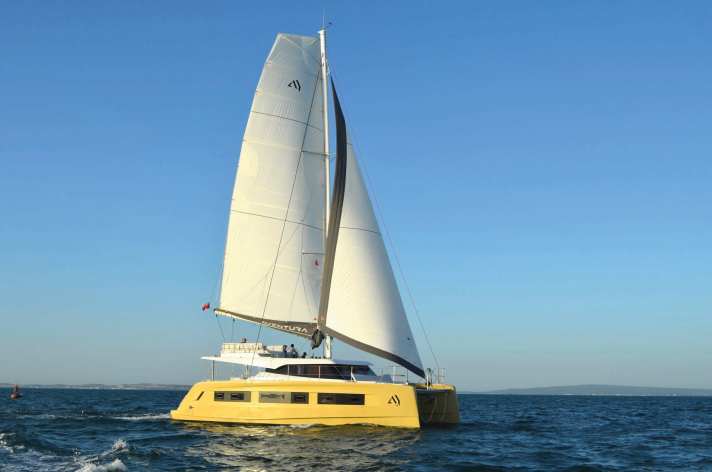
The layout of the Aventura 45 provides for an unusual variety. Layout variants with three, four, five or six cabins are possible. The modern, very voluminous hull moulds were designed by Studio Samer Lasta. Read more here.
Bali 4.6
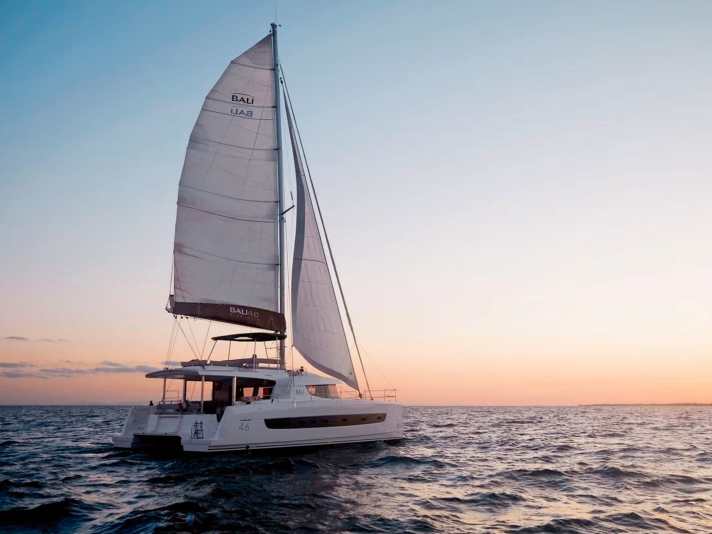
In the exciting ship concept from Bali in France, the platform between the hulls is laminated through from the sterns all the way to the bows. This creates even more options for variance and flexible utilisation.
Fountaine Pajot FP 44
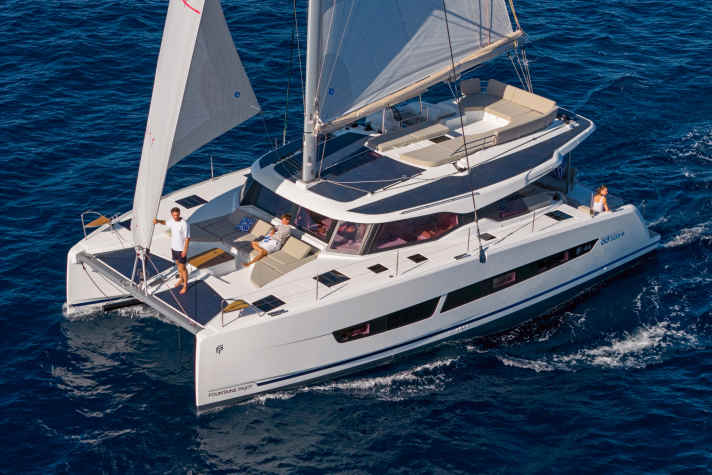
The design by Berret-Racoupeau follows on from the successful Elba 45, but is somewhat smaller and narrower. The new one from Fountaine Pajot offers a flybridge lounge and a very spacious front cockpit. Read more here.
Lagoon 46 Iconic

With the Iconic version, market leader Lagoon has launched a revised version of the successful Lagoon 46 (read the detailed test here) was launched on the market. In particular, the lounge areas on the foredeck and flybridge have been redesigned.

